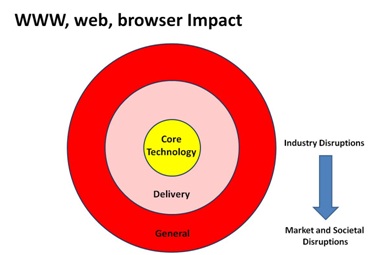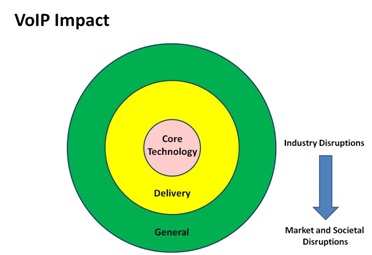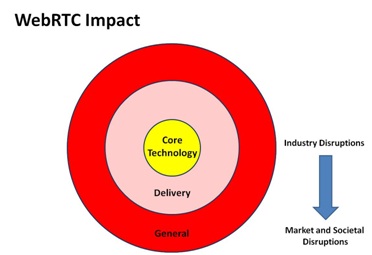To understand how technology will impact the future, it is critical to think in the context of the past. As George Santayana said, “Those who cannot learn from history are doomed to repeat it.” The history to which I refer is the original introduction of the World Wide Web (www or Web for short) and the original HTML browser. When these technologies were introduced in 1991-3, there were many who said that they were not interesting or transformational. In fact, the quote "I can do that with AOL" was often heard at that time. What was not clear was the impact of an explosion of users and websites and the emerging relationship of open movement between them. The pre- Web/browser world was a world of dedicated server connections and defined services. With the browser and the web, users were freed to go directly to where the information they wanted resided.
WebRTC creates the same transformation in communications that the Web and browser created for information. No longer will users be limited by their server to whom and how they communicate, but rather freed to use the Web paradigm to connect to any server that can define a communications experience.


To really understand if a technology is disruptive, three areas must be considered:
- Core Technology - The industry the technology is actually in - the segment base
- Delivery - Industries or services that deliver the technology to customers
- General - Adjacent or other industries that are impacted by the change
If we look at the original Web/browser, it is clear that all three were impacted in major ways. The Core IT industry changed and introduced players that used the web/browser to develop new products and displace existing players, however, it was not totally a disruption. Microsoft stayed a player with the browser and eventually Bing, IBM is still there, and others have continued. In the services segment the changes were more dramatic, for example AOL disappeared and Yahoo emerged. Finally, the Web/browser impacted many other industries. From classified ads that were replaced by eBay and craigslist to changing the model for banking and insurance, from retail to even entertainment, virtually every industry has been changed in dramatic fashion. Finally, entire new multi-billion dollar business segments have been created, from search to social , dating to sex. We would definitely say that the Web/browser was disruptive.
On the other hand, VoIP has been much less disruptive and more evolutionary. While it had a major impact in telecom world, with the emergence of Cisco and others, it did not cause a complete change. In fact, the technology was adopted by the incumbents. In the service segment, the impact was even less. While some channel partners changed, generally, the service providers and channels for telecom remained the same. While Skype and SIP trunking have impacted the business, they have not caused landscape shifts that are dramatic. Finally, the impact of VoIP on the customer business has been purely evolutionary. It has not enabled major shifts in other industries nor caused new industries outside of telecom to be created.

So, for a technology to be truly disruptive, it must create major changes outside of the core industry.
Evaluating WebRTC on this scale can lead us to understand the potential for disruption.

Telecom Equipment Industry - in the core industry, WebRTC is a potential major change element. It allows new players in the conferencing and Web conferencing spaces to enter quickly. It pushes the web site and contact center parts of organizations together, opening the way for market share gains through that change. It allows vendors to change the landscape. However, it will be adopted by the existing vendors for BYOD, guest portals, and contact center, assuring that they will not be totally displaced.
The Service provider industry - WebRTC could be a much larger disrupter in the services space. For traditional telecom service providers, the ease of OTT and site dependent communications could reduce the need for their services. Enterprises adopting WebRTC for sootier care and guest portals may have a dramatically reduced the need for PSTN trunk access. Large industries like conferencing may be dramatically changed. In the channel space, the need for Web integration may drive major changes
In the customers - For actual end customer companies, WebRTC is probably more of a disrupter than for the others. It makes real-time communications something that is available anywhere, anytime for business process and customers. By implementing WebRTC properly, companies can get significant advantage. In healthcare, WebRTC enables new models to interact with home bound patients using video without plug-in and using readily available devices. It can reduce doctor hospital visits during the day, increasing efficiency, and it can expedite billing management. In retail, it can create new in-store experiences as users have WebRTC enabled in the physical store for personal assistants and staff interaction. In fact, in virtually any industry, a clear and compelling use of WebRTC for change can be readily created. And the potential goes further, as WebRTC become available, new business models will be created.
With this analysis, it is clear that WebRTC has the potential to be a true disrupter.
Edited by
Brooke Neuman